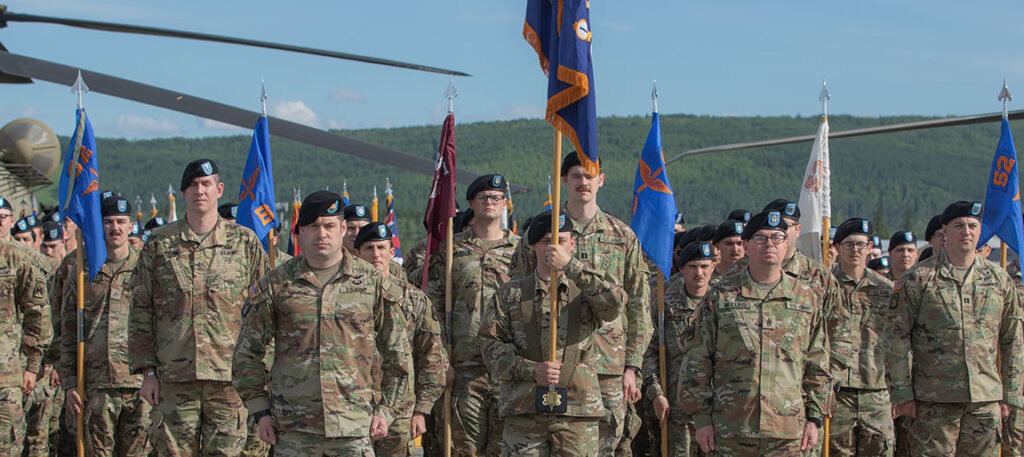Soldiers of 1-52 General Support Aviation Battalion and 1-25 Attack Reconnaissance Battalion stand in formation in June 2024 before being patched as members of the 11th Airborne Division’s new Arctic Aviation Command during a ceremony at Fort Wainwright, Alaska. SPC. KOURTNEY NUNNERY/U.S. ARMY
THE WATCH STAFF
U.S. Army helicopter pilots assigned to operate in Arctic conditions will be incorporated into a newly unified Arctic force, the Arctic Aviation Command — which falls under the umbrella of the 11th Airborne Division — as the military continues to reprioritize the Far North in the face of changing climate and rising tensions with Russia and the People’s Republic of China. The command, located at Fort Wainwright, just outside Fairbanks, Alaska, already incorporates 1st Battalion, 52nd Aviation Regiment, and 1st Battalion, 25th Aviation Regiment. Those units previously reported to headquarters at Joint Base Lewis-McChord near Seattle and Fort Shafter in Hawaii. “You have to be in the Arctic to understand the Arctic,” Col. Russ Vanderlugt, the Aviation Command’s new commander, told Task & Purpose, a military news website.
The Arctic Aviation Command was officially stood up on August 8, 2024. Although the reorganization won’t increase the number of aviation assets in Alaska, it does mean that the command leadership will be in Alaska, allowing for a more hands-on approach to training and a more direct line of support. The new Alaska-based command can now make major flying decisions without having to get approval from far-removed headquarters. The 11th Airborne Division was reactivated in June 2022 as part of the U.S. Arctic strategy to increase operational capability and response time in the region. “A lot of forces will flow through Alaska. Our alignment here puts the aviation assets in the 11th Airborne really at the tip of the spear to be able to go anywhere quickly,” Vanderlugt told Task & Purpose. “It’s strategic. It’s intentional that we’re growing this capability here.” The division is headquartered at Joint Base Elmendorf-Richardson.
The only way to effectively operate in the Arctic is to train in the region’s austere conditions. “That’s a huge part of Arctic soldiering up here,” Vanderlugt told the news site. “That’s going to be a big focus for me as a commander because what’s really important is during the Arctic night when the sun doesn’t even rise in many parts of Alaska, you have to get outside. You can’t just go to the weight room or to the gym, but you gotta get outside and do these Arctic activities in the cold, and it helps you acclimate to it.”
The Alaska units have already upgraded some helicopters and installed windscreens that allow door gunners to operate their weapon systems, even in sub-zero temperatures. The new command will also help refine helicopter tactics in the Arctic and should help the Army refine its tactics and doctrine for the region. “In order to help the commander assess tactical risk and save the lives of pilots, I’m looking to maximize survivability wherever possible,” Vanderlugt said. “The operational environment is really harsh on us, and survivability extends to all war fighting functions that aviation has to use.”
Transporting food, fuel and ammunition to forward-operating locations is a challenge. The extreme cold often destroys batteries and makes it hard to fire weapons. Landing helicopters in the snow is more challenging than in sand or other topographies. One test currently underway is a wind deflector for Chinook helicopter gunners to make it easier to operate their weapons. “Flying even at zero degrees with the window open, when you’re doing 100 knots, the wind chill is just too much. A window deflector will hopefully help them with being able to open their 7windows and utilize their weapon systems as well,” Chief Warrant Officer 3 Michael Harms, the command’s aviation mission survivability officer, told Task & Purpose.
The creation of the Arctic Aviation Command also means that all the troops within the 11th Division will wear the same ‘Arctic Angels’ blue patch with a red and white emblem with angel wings.
“When you take two separate organizations that are reporting to Hawaii and Washington, they’re wearing the patches of those organizations and their identity and their purpose and their mission is aligned to those organizations,” Vanderlugt said. “Now, we’re bringing it all under one organization, the Arctic Aviation Command. We wear one patch.”

